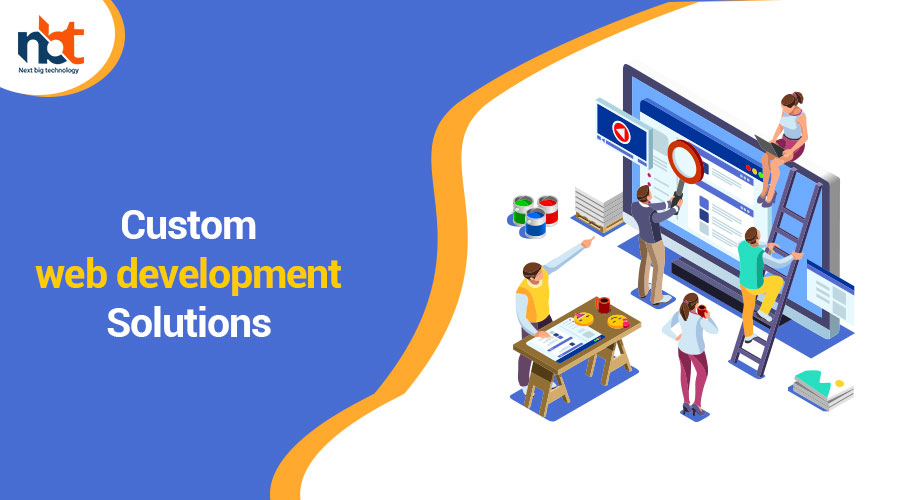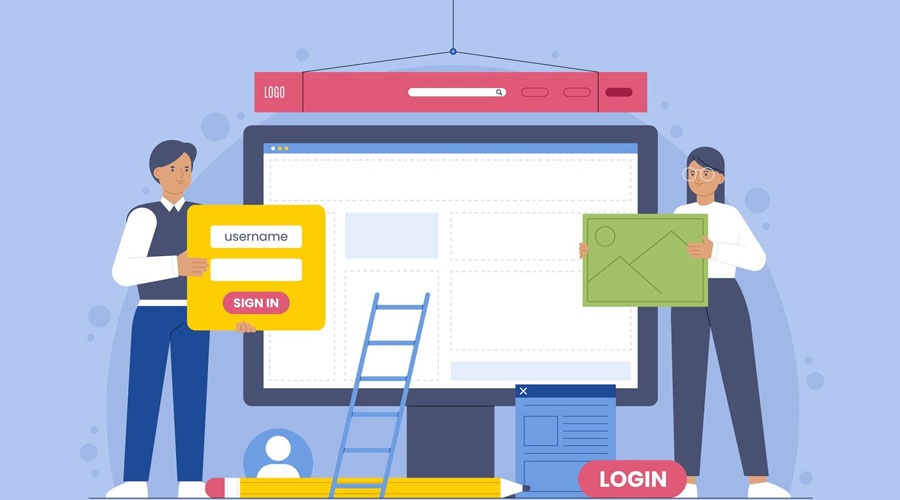Table of Contents
Introduction to Custom Web Development
In the fast-paced and ever-evolving digital landscape, having a strong online presence is the cornerstone of business success. Your website is often the first point of contact with potential customers, making it crucial to leave a lasting impression. Generic, one-size-fits-all solutions may have sufficed in the past, but in today’s competitive market, the need for tailored, custom web development solutions has become paramount.
Custom web development is more than just a buzzword; it’s a strategic approach that can transform your online presence and help you achieve your business goals effectively. In this article, we will explore the fundamental concepts of custom web development, its significance, and why it’s the key to unlocking your online potential.
Defining Custom Web Development
Custom web development, at its core, is the process of creating websites and web applications that are uniquely designed and developed to cater to the specific needs and requirements of a business or individual. Unlike pre-designed templates or off-the-shelf solutions, custom web development ensures that your website is not just another face in the crowd but a digital extension of your brand identity, goals, and audience.
It’s like a bespoke suit tailored to fit your unique measurements, providing a perfect fit and unmatched comfort compared to an off-the-rack alternative.
The Significance of Custom Web Development
In a digital era where innovation and user experience are paramount, custom web development offers a plethora of advantages that can significantly impact your business’s success.
1. Aligning Your Website with Your Brand
Your website is your virtual storefront. Just as a brick-and-mortar store’s appearance and ambiance should reflect the brand’s identity, your website should do the same. Custom web development allows you to align your website’s design, features, and content with your brand’s identity, ensuring a cohesive and memorable user experience.
2. Prioritizing User Experience
User experience is a top priority in today’s digital landscape. A custom-developed website puts you in control of the user interface and experience, ensuring a smooth, intuitive, and engaging journey for your visitors. This not only keeps users on your site for longer but can also lead to higher conversion rates.
3. Gaining a Competitive Edge
With countless websites vying for users’ attention, custom web development gives you the competitive edge you need to stand out. By offering innovative features, functionalities, and a unique design, you can leave a lasting impression on your audience.
4. Scalability and Adaptability
Businesses evolve over time, and so should your website. Custom web development ensures that your site is flexible and scalable, allowing you to adapt to changing business needs, integrate new features, and expand your online presence seamlessly.
5. SEO Optimization
Search engine optimization (SEO) is crucial for visibility in search engine results. Custom web development allows you to build a website from the ground up, optimizing it for search engines. This results in a well-structured, fast-loading, and responsive site that can rank higher in search results.
Benefits of Custom Web Development
The advantages mentioned in the previous section, custom web development offers several other notable benefits that can have a significant impact on your online presence and business success. Here are some additional benefits of custom web development:
- High Level of Security: Custom web development allows you to implement robust security features and practices specific to your website. This is crucial, especially if your site handles sensitive user data or financial transactions. You can incorporate advanced security measures to protect against cyber threats and data breaches.
- Tailored Content Management: Custom content management systems (CMS) are designed to meet your specific content management needs. This provides you with more control over your website’s content and makes it easier for non-technical staff to update and maintain the site.
- Optimized Performance: Custom web development allows developers to fine-tune your website’s performance, resulting in faster loading times and seamless user experiences. This optimization can significantly impact user engagement and satisfaction.
- Integration with Third-Party Services: Custom solutions enable seamless integration with third-party services, such as payment gateways, CRM systems, email marketing platforms, and social media APIs. This can streamline business operations and improve the user experience.
- Scalability and Growth: As your business expands, your website must adapt. Custom development allows for easy scalability, enabling you to add new features, expand your product offerings, and accommodate increased website traffic without major overhauls.
- Cross-Browser and Cross-Platform Compatibility: Custom-built websites are thoroughly tested to ensure they work flawlessly across various web browsers and devices, including desktops, smartphones, and tablets. This guarantees a consistent user experience for all visitors.
- Unique Functionality: With custom development, you can create unique functionalities that cater to your specific business needs. Whether it’s a custom e-commerce solution, a booking system, or a complex data management tool, you have the flexibility to develop precisely what you require.
- Brand Consistency: Your website is an extension of your brand, and custom web development ensures that every element, from color schemes to typography, aligns with your brand guidelines. This consistency helps in building brand recognition and trust.
- Better Analytics and Reporting: Custom web development allows you to integrate advanced analytics tools and tracking features that provide detailed insights into user behavior, helping you make data-driven decisions for further optimization.
- Long-Term Cost Efficiency: While the initial investment in custom web development may be higher than using pre-designed templates, it can be more cost-effective in the long run. With custom solutions, you’re less likely to encounter compatibility issues, frequent updates, or the need for a complete website overhaul.
- Improved Loading Speed: Custom websites can be optimized for faster loading times, reducing bounce rates and improving search engine rankings. A speedy website also enhances user satisfaction and engagement.
- Compliance with Industry Standards: Custom development allows you to ensure that your website complies with industry-specific regulations and standards, such as ADA accessibility requirements or data privacy laws like GDPR.
- Enhanced Mobile Experience: With the growing number of mobile users, having a responsive website is crucial. Custom development ensures that your site is mobile-friendly and offers a seamless experience on smartphones and tablets.
- Custom SEO Strategy: A custom-built website enables you to implement a tailored SEO strategy from the ground up. This includes optimizing site structure, meta tags, content, and images for better search engine visibility.
Key Elements of Custom Web Development
Custom web development is a meticulous process that involves various key elements to ensure the creation of a unique and high-performing website or web application. These key elements are crucial for the success of any custom web development project. In this section, we will delve deeper into these elements to provide a comprehensive understanding of what goes into the development of a custom website.
-
Requirements Gathering and Analysis:
- The initial step in custom web development involves understanding the client’s needs and goals. This includes in-depth discussions, documentation, and analysis of the project’s requirements. A clear understanding of what the client wants is essential for the project’s success.
-
Project Planning:
- After gathering requirements, a comprehensive project plan is created. This includes defining the scope, timeline, budget, and resources required for the project. A well-structured plan is crucial for keeping the project on track and within budget.
-
User-Centered Design:
- User experience (UX) and user interface (UI) design are key elements of custom web development. Designers focus on creating an intuitive and visually appealing interface that ensures a positive user experience. Design decisions are influenced by the target audience and the client’s brand identity.
-
Technology Stack Selection:
- The choice of the technology stack (programming languages, frameworks, databases, etc.) is a critical decision in custom web development. The selection should align with the project’s requirements and objectives, ensuring scalability, security, and performance.
-
Front-End Development:
- Front-end development involves the creation of the visible and interactive elements of the website that users interact with. This includes the layout, design, and functionality of the site’s user interface. HTML, CSS, and JavaScript are commonly used for front-end development.
-
Back-End Development:
- Back-end development focuses on server-side functionality. Developers work on databases, server configuration, and business logic. They ensure that data is processed, stored, and retrieved efficiently, and they implement the website’s core functionality.
-
Database Development:
- The database is crucial for storing and managing data. Custom web development includes designing and implementing a database structure that is efficient, secure, and scalable to handle the website’s data requirements.
-
Integration of Third-Party Services:
- Custom web development often requires integrating third-party services and APIs (Application Programming Interfaces) to enhance functionality. For example, integrating payment gateways, social media platforms, or analytics tools can be part of the project.
-
Testing and Quality Assurance:
- Thorough testing is an integral part of custom web development. This includes various types of testing such as functionality testing, usability testing, security testing, and performance testing. Quality assurance ensures that the final product is free of errors and meets the specified requirements.
-
Optimization for Performance:
- Optimizing the website’s performance is essential to ensure fast loading times and a smooth user experience. This involves minimizing code and resource usage, optimizing images, and utilizing content delivery networks (CDNs) where necessary.
-
Security Measures:
- Custom web development also includes implementing robust security measures to protect the website and its users. This includes measures like encryption, firewall protection, regular security audits, and data encryption for sensitive information.
-
Content Management System (CMS):
- Depending on the project’s requirements, a custom CMS may be developed to allow the client to manage and update website content easily. Custom CMS solutions are tailored to the specific needs of the website.
-
Launch and Deployment:
- Once the development and testing phases are complete, the website is deployed to its hosting environment. This is a critical step in making the website accessible to users.
-
Training and Documentation:
- Custom web development projects often include training for the client’s team on how to manage and update the website. Additionally, documentation is provided to ensure that the client has comprehensive guidelines for ongoing maintenance.
-
Ongoing Maintenance and Support:
- Post-launch, ongoing maintenance and support are essential to keep the website running smoothly. This includes updates, security patches, and addressing any issues that may arise.
-
Performance Monitoring and Analytics:
- Web developers continuously monitor the website’s performance and use analytics tools to gather data on user behavior. This data is used to make informed decisions for further improvements and optimizations.
Choosing the Right Technology Stack
When embarking on a custom web development project, one of the most critical decisions you’ll make is selecting the right technology stack. The technology stack you choose will significantly impact the development process, the performance of your website, and its scalability. In this article, we will explore the importance of choosing the right technology stack for custom web development and provide insights into how to make informed decisions.
I. What is a Technology Stack?
A technology stack, also known as a tech stack or software stack, refers to a combination of programming languages, frameworks, libraries, and tools used to build a web application or website. It encompasses both the front-end (client-side) and back-end (server-side) components of your web project.
II. The Importance of Choosing the Right Technology Stack
- Development Efficiency
The choice of technology stack directly affects the development process. An appropriate stack can streamline development, reduce development time, and minimize coding effort. Conversely, an ill-suited stack can lead to inefficiencies, causing delays and increasing development costs.
- Performance
Different technology stacks have varying performance characteristics. The right stack can ensure your website runs smoothly, loads quickly, and provides a responsive user experience. Poorly chosen technology can lead to performance bottlenecks and sluggish user interactions.
- Scalability
As your business grows, your website must be able to handle increased traffic and additional features. A well-selected technology stack will facilitate easy scalability, allowing your site to grow without significant architectural changes.
- Security
Security is paramount in web development. The choice of technology stack can impact the security of your site. Vulnerabilities in outdated or poorly maintained technologies can pose risks to your website and user data. The right stack includes security features and facilitates best practices for web security.
- Compatibility
The technology stack should be compatible with various browsers and devices. Compatibility issues can lead to a subpar user experience, causing frustration and potentially driving users away.
III. Factors to Consider When Choosing a Technology Stack
- Project Requirements
Begin by understanding the specific requirements of your project. Consider factors like the complexity of your web application, its functionality, and the expected user base. Smaller projects with simpler needs may require different technologies than large-scale, feature-rich applications.
- Expertise and Skills
Evaluate the skills and expertise of your development team. Choosing technologies with which your team is familiar can lead to a smoother development process and fewer learning curve challenges. If you plan to hire developers, consider the availability of professionals with expertise in your chosen stack.
- Community and Support
The strength of the technology’s community and available support resources is crucial. Established technologies with active communities often provide a wealth of resources, libraries, and plugins. This can simplify development and troubleshooting.
- Performance Requirements
Consider the performance demands of your web application. Will it handle a large volume of concurrent users? Does it need to process real-time data? Depending on these requirements, you may need a technology stack with strong performance capabilities, such as a robust back-end framework or a content delivery network (CDN).
- Scalability
Scalability is vital, especially if you anticipate growth. Ensure that your chosen technology stack allows for horizontal and vertical scalability, enabling your website to handle increased traffic and feature expansion.
- Security
Security should be a top priority. Assess the security features of your chosen stack and ensure it allows for secure data handling, encryption, and protection against common web vulnerabilities like SQL injection and cross-site scripting (XSS).
IV. Common Technology Stack Components
- Front-end Technologies
- HTML, CSS, and JavaScript: The fundamental building blocks of the front end.
- Front-end Frameworks: Options like React, Angular, and Vue.js offer enhanced development capabilities.
- Responsive Design: Ensures your website adapts to various screen sizes and devices.
- Back-end Technologies
- Server-Side Languages: Options include PHP, Python, Ruby, Node.js, and more.
- Back-end Frameworks: Popular choices are Ruby on Rails, Django, Express.js, and Laravel.
- Databases: MySQL, PostgreSQL, MongoDB, and others for data storage.
- Web Servers: Apache, Nginx, or other server software to handle requests.
- APIs: Develop and integrate with APIs for additional functionality.
- Hosting and Infrastructure
- Hosting Providers: Select a reliable hosting service that suits your project’s requirements (e.g., AWS, Azure, or shared hosting).
- Content Delivery Networks (CDNs): Enhance website performance and load times by leveraging CDNs like Cloudflare or Akamai.
Custom Web Development vs. Off-the-Shelf Solutions
In the ever-evolving digital landscape, businesses are presented with a crucial decision regarding their online presence: whether to opt for add-on custom web development or off-the-shelf solutions. Each approach has its own set of advantages and drawbacks. In this article, we will explore the key differences between these two options and help you make an informed decision about which one is best suited for your business.
I. Custom Web Development Add-Ons
- Tailored Functionality
Custom web development add-ons are additional features or modules that are specifically designed to meet your business’s unique requirements. They can be seamlessly integrated into your existing website to enhance its functionality. Whether you need a customized e-commerce solution, a unique booking system, or a specialized customer portal, custom add-ons can provide tailored solutions.
- Personalization
Custom web development add-ons allow for a high degree of personalization. You can request specific features and design elements that align perfectly with your brand identity and customer needs. This level of personalization can help you create a distinctive and memorable online presence.
- Scalability
As your business grows, so do its requirements. Custom add-ons can be scaled and expanded to accommodate increasing traffic, data, and functionality. This scalability ensures that your website remains efficient and effective in the long term.
- Performance Optimization
Custom add-ons are developed with your website’s unique requirements in mind. This means that they can be optimized for performance, resulting in faster loading times, lower bounce rates, and improved user engagement.
- Security
Security is a top priority in the digital age. Custom add-ons can be developed with robust security measures to protect your website and customer data. This is particularly crucial if your website handles sensitive information.
II. Off-the-Shelf Solutions
- Quick Deployment
Off-the-shelf solutions, such as pre-designed themes and plugins, offer a rapid way to add functionality to your website. They can be easily installed and configured, saving you time and effort in the short term.
- Cost-Effective
Off-the-shelf solutions are often more budget-friendly than custom development. Since they are mass-produced, they benefit from economies of scale, making them a cost-effective option for small businesses or startups.
- Maintenance and Support
Many off-the-shelf solutions come with regular updates and support from the developers. This can be convenient as it reduces the need for in-house technical expertise and ongoing maintenance.
- Community and Documentation
Off-the-shelf solutions often have active user communities and extensive documentation. This can be helpful when you encounter issues or need assistance with configuration and customization.
- Compatibility
Off-the-shelf solutions are typically designed to work with a wide range of website platforms and content management systems, ensuring compatibility and ease of integration.
III. Making the Right Choice
- Consider Your Business Needs
The first step in making the right choice is to carefully consider your business needs. Custom web development add-ons are ideal when your business requires unique features or when your website is a critical component of your operations. Off-the-shelf solutions are suitable for businesses with more straightforward requirements.
- Assess Long-Term Goals
Think about your long-term goals and scalability. If you anticipate significant growth or have specific plans for your website’s development, custom add-ons may be a better choice. Off-the-shelf solutions can be a temporary solution but may not scale as effectively.
- Budget and Resources
Consider your budget and available resources. Custom development can be costlier and may require more time and technical expertise. Off-the-shelf solutions are often more budget-friendly but may require less customization and have limitations.
- Security and Data Sensitivity
If your website deals with sensitive customer data or requires a high level of security, custom add-ons may be the safer choice. Off-the-shelf solutions, while convenient, may not provide the same level of security customization.
- User Experience and Brand Identity
If creating a unique user experience and maintaining a strong brand identity are crucial for your business, custom development add-ons are the better option. They allow for a higher degree of personalization and brand alignment.
Cost Estimation and Budgeting
In the realm of project management, it’s not uncommon for additional features or enhancements to be requested after the initial project scope has been defined. These add-ons can provide valuable improvements, but they also bring the challenge of estimating their costs and incorporating them into the budget. This article explores the crucial process of add-on cost estimation and budgeting, highlighting the importance of managing project changes effectively and providing insights into best practices for handling project enhancements.
I. The Significance of Add-On Cost Estimation
- Enhancing Project Value
Add-ons can greatly enhance the value of a project by introducing new features, improving functionality, or addressing unforeseen issues. Properly estimating the costs of these enhancements ensures that their benefits outweigh their expenses.
- Client Satisfaction
Accurate add-on cost estimation plays a vital role in managing client expectations. Clients need to know the financial impact of project changes to make informed decisions and ensure that their requirements are met.
- Budget Management
Effective add-on cost estimation is essential for maintaining the project budget. Without proper estimates, projects can easily overrun their budgets, leading to financial strain and delays.
II. Challenges in Add-On Cost Estimation
Estimatin
- Uncertainty
g the cost of add-ons is often complicated by the uncertainty of project changes. New features or requirements may not be well-defined, making it challenging to predict their financial impact accurately.
- Scope Creep
Inadequate add-on cost estimation can lead to scope creep, a phenomenon where project requirements expand beyond the initially defined scope. This can result in project delays, increased costs, and reduced client satisfaction.
- Resource Allocation
Properly estimating add-on costs is crucial for resource allocation. It ensures that the necessary personnel, materials, and time are available to implement the changes effectively.
III. Best Practices for Add-On Cost Estimation
- Collaborate with Stakeholders
Engage with clients and project stakeholders to gather a clear understanding of their requirements. Open communication can help identify the specific goals of the project enhancements and any constraints related to time or budget.
- Break Down Requirements
Divide the add-on requirements into smaller, manageable components. This makes it easier to estimate the cost of each individual element, reducing uncertainty.
- Use Historical Data
Leverage historical project data to inform your add-on cost estimation. Past projects with similar enhancements can provide valuable insights into the potential costs and challenges associated with the changes.
- Involve Experts
If the add-ons require specialized skills or knowledge, involve experts early in the estimation process. Their expertise can help provide more accurate cost estimates.
- Consider Contingencies
Given the inherent uncertainty in project enhancements, it’s wise to include a contingency fund in your budget to account for unforeseen costs. This can help mitigate the impact of any unexpected expenses.
IV. Incorporating Add-On Costs into the Budget
- Create a Change Control Process
Establish a change control process within your project management framework. This process should outline how add-ons are requested, evaluated, estimated, approved, and incorporated into the budget.
- Review and Approval
Ensure that all proposed add-ons undergo a thorough review and approval process. This includes estimating the costs, assessing their impact on the project timeline, and gaining client approval before proceeding.
- Budget Revision
Once an add-on is approved, update the project budget to include the estimated cost of the enhancement. This should be done in a transparent and traceable manner to maintain financial accountability.
- Monitor and Communicate
Continuously monitor the progress of the project and the impact of add-ons on the budget. Regularly communicate with clients and stakeholders to keep them informed of any changes.
Future Trends in Custom Web Development
In the ever-evolving world of web development, staying up-to-date with current trends and anticipating future changes is crucial. Custom web development solutions, while highly effective today, must adapt to the rapidly changing digital landscape to remain competitive and relevant. In this article, we will explore some of the emerging trends in custom web development that are shaping the future of online presence.
I. Responsive Web Design
Responsive web design is not a new concept, but it continues to be a crucial trend in custom web development. With the increasing use of mobile devices for internet access, ensuring that your website is responsive and mobile-friendly is paramount. Future trends in responsive design involve even more fluid and flexible layouts that can seamlessly adapt to various screen sizes and devices, enhancing the user experience further.
II. Progressive Web Apps (PWAs)
Progressive Web Apps, or PWAs, are becoming increasingly popular in custom web development. These apps offer the best of both worlds, combining the advantages of web and mobile applications. They are reliable, fast, and engage users with features like offline access and push notifications. The future of custom web development will see more businesses investing in PWAs to provide a seamless and app-like experience to their website visitors.
III. Voice Search Optimization
With the growing adoption of voice-activated devices like smart speakers and smartphones with virtual assistants, voice search optimization is a trend that will continue to gain significance. Custom web development solutions will need to incorporate voice search capabilities, such as optimizing content for voice queries and improving natural language processing on websites.
IV. Artificial Intelligence and Machine Learning
AI and machine learning are revolutionizing custom web development. These technologies can provide personalized content recommendations, chatbots for customer support, and enhanced data analytics. Custom web development will increasingly involve the integration of AI and machine learning to create smarter and more user-centric websites.
V. Enhanced Security
As cyber threats continue to evolve, web development trends are placing a greater emphasis on security. Custom web development solutions will need to incorporate robust security measures, including SSL certificates, regular security audits, and secure coding practices to protect both the website and user data.
VI. Augmented Reality (AR) and Virtual Reality (VR)
AR and VR technologies are set to play a significant role in the future of custom web development. These immersive experiences have the potential to transform various industries, including e-commerce, education, and entertainment. Websites will increasingly integrate AR and VR elements to create interactive and engaging user experiences.
VII. Microinteractions
Microinteractions are subtle animations or design elements that provide user feedback and enhance the overall user experience. Custom web development solutions will leverage microinteractions to create more engaging and intuitive websites. These small, yet impactful design elements add an extra layer of interactivity to websites.
VIII. Single-Page Applications (SPAs)
Single-page applications (SPAs) offer a smooth and fast user experience by loading content dynamically without refreshing the entire page. The future of custom web development will see an increased adoption of SPAs, which are especially well-suited for web applications and sites that require real-time data updates.
IX. Dark Mode
Dark mode has gained popularity due to its benefits in reducing eye strain and saving battery life on certain devices. Custom web development solutions will include the option for users to switch between light and dark modes, enhancing the accessibility and usability of websites.
X. Blockchain Integration
Blockchain technology is not limited to cryptocurrencies; it has applications in various industries, including web development. The use of blockchain can enhance security, transparency, and data integrity on websites. Custom web development will increasingly explore ways to integrate blockchain into e-commerce, data storage, and authentication processes.
















